 Sacramento, California – If you haven’t gone shopping for a new Toyota Prius in recent months, be advised that you need to take along a calculator and a scorecard.
Sacramento, California – If you haven’t gone shopping for a new Toyota Prius in recent months, be advised that you need to take along a calculator and a scorecard.In an effort to please seemingly everybody, Toyota is offering a blizzard of Prius variations, distinguished by capital letters, lower-case letters, numbers, Roman numerals and maybe even alien spacecraft symbols from what I can tell.
Trade magazines and fellow auto reviewers have struggled to deal with the situation, throwing out widely varying names of the same model and using the words hatch, midsize, compact, subcompact, crossover and wagon like they were M&Ms out of the same bag.
You can get a traditional Prius hatch (think Classic Coke), a Prius c model that’s tiny, a plug-in Prius that drinks in power via that very device and a Prius v that’s sort of a small SUV or crossover.
Confusing? Omigod, yes!
Here’s what I know: I recently had a 2012 Toyota Prius v Three for a week. It ran well. I liked it.
Whew, glad we got that settled. If you must know, the “v” in the model name stands for versatility. I’m not making this up; it’s right there on the Toyota website.
But what’s in a name? You want to know how it drives.
While I could go into exhaustive details about the special virtues of the v Three – easy opening and loading rear cargo door, plentiful cargo-carrying space in the back with seats folded, crossover styling that doesn’t intimidate the consumer looking for a small vehicle with utility – the appeal of this Prius is old-school.
It drives like a finely tuned, gas-fueled car, making you feel instantly comfortable with the flawless, impressive technology that surrounds you. It’s smooth and quiet on freeways and as agile as a world-class skier on busy city streets. The cooperative work of gas engine and electric motor is seamless.
And you really don’t have to think about anything but driving, no matter how much data the car’s information center is throwing at you. The bonus: You really feel good about your gas mileage. For my tester, it was an advertised 44 miles per gallon in the city and 40 mpg on the highway. Those aren’t the nation’s top numbers, but they’re very good.
Even this fairly loaded-up version of the Prius is reasonable, with a starting price of $27,165, which gets you many of the standard interior features you expect to see in a mainline Camry.
Is this a car you can live with in times of $4-a-gallon gas and long intervals between shopping visits to local car lots? It is precisely that … no matter what you call it.


